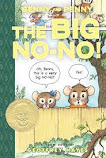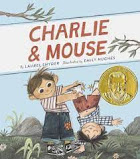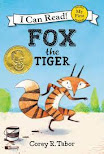1. Hayes, G. (2015). Benny and Penny in the big no-no! Minneapolis, MN: Spotlight.
Blog: Benny and his sister Penny know it's wrong to sneak into someone else's backyard but their mysterious new neighbor may be a monster and a thief! They go snooping and discover a lot about themselves and make a new friend.
Summary: Two mice meet their new neighbor and discover that she is not as scary as they feared.
Similar Titles: Benny and Penny in just pretend by Geoffery Hayes; Little Mouse gets ready by Jeff Smith
2. Kang, A., & Weyant, C. (2019). You are (not) small. Singapore: Scholastic Singapore.
Blog: Fuzzy, bearlike creatures of different sizes relate to one another in an amusing story that explores the relative nature of size. A small purple creature meets a similarly shaped but much larger orange critter. The purple creature maintains that the orange creature is "big"; the orange one counters by calling the purple one "small." This continues, devolving into a very funny shouting match, pages full of each type of creature hollering across the gutter. This is followed by a double-page spread depicting two huge, blue legs and the single word "Boom!" in huge type. Tiny, pink critters then float down by parachute, further complicating the size comparisons. Eventually, these brightly colored animals learn to see things in a different way. In the end, they decide they are all hungry and trudge off to eat together. The story is told effectively with just a few words per page, though younger readers might need help understanding the size and perspective concepts. While the story itself seems simple, the concepts are pertinent to several important social issues such as bullying and racism, as well as understanding point of view. Charming characters, a clever plot and a quiet message tucked inside a humorous tale.
Summary: Two fuzzy creatures can't agree on who is small and who is big, until a couple of surprise guests show up, settling it once and for all!
Similar Titles: Big little brother by Kevin King; Ernest, the moose that doesn't fit by Catherine Rayner
3. Kvasnosky, L. M. (2006). The runaways. Cambridge, MA: Candlewick.
Blog: The Fox sisters discover that not even running out to hide in the yard will save them from yet another lunch of cucumber sandwiches, that it's not a good idea to put something you'll miss into a time capsule and that a sprinkle of "creative juices" made from a secret formula can dispel the most stubborn case of writer's block. As in previous stories/episodes, the sisters, their parents and Ivy's friend Eugene (the one who suggests the "creative juice") are depicted as long-nosed foxes, furred in various bright orange tones but placed in human settings. Unlike previous outings, these tales are presented in easy-reader format, and they'll make tasty fare for newer readers.
Summary: In three short stories, two fox sisters run away from home, bury a time capsule, and take advantage of some creative juice.
Similar Titles: The fox who ate books by Franziska Biermann; One fine day by Nonny Hogrogian
4. LaRochelle, D., & Wohnoutka, M. (2020). See the cat: Three stories about a dog. Somerville, MA: Candlewick.
Blog: The first line of text, large black font on a white verso page, is "See the cat." On the recto page, a yellow dog proudly declares in speech bubble text, "I am not a cat. I am a dog." As descriptors of the cat accumulate, dog Max grows more and more indignant until indeed a cat does appear and the text "See the red dog" is paired with red-cheeked Max admitting, "I am so embarrassed." In the second story, the narrator begins, "See the snake" as Max responds, "Here we go again." The jig is up, however, as Max cleverly averts the dangerous snake by using a pencil to write in a different ending. In the third story, Max takes control by threatening to leave the book when the narrator again tries to manipulate him. As Max progresses from confused to canny to competent, children will find a reflection of their own reading journey as well as amusement at the aspect of a dog wrestling with a book.
Summary: Max is not a cat, Max is a dog. But much to Max's dismay, the book keeps instructing readers to "see the cat." How can Max get through to the book that he is a DOG? In a trio of stories for beginning readers, author David LaRochelle introduces the excitable Max, who lets the book know in irresistibly emphatic dialogue that the text is not to his liking. The three stories build to an immensely satisfying conclusion.
Similar Titles: Bad dog by Mike Boldt; The book with no pictures by BJ Novak
5. Long, E. (2012). Up, tall and high! New York: G.P. Putnam's Sons.
Blog: With the help of a flock of brightly colored, googly-eyed birds and some gatefold pages, Long explores the title's three words in a trio of short stories with the vibe of an animated educational TV clip. "I am tall," declares a self-satisfied orange bird. "I am tall," says a purple bird, who towers over him to the first bird's chagrin. A pair of impossibly long bird legs steps in between them-"I am tall" shouts a voice from above-then a gatefold page opens to reveal a squat green bird on stilts. "You are not tall!" the exasperated birds on the ground protest (the decidedly not tall green bird gets the last laugh, though, with a flashy tail display). In another story, a gatefold (and a bunch of balloons) help a nonflying penguin soar high, while, in the last entry, a flap makes two birds "up" in a tree come crashing down.
Summary: In three laugh-out-loud situations, an irresistible cast of colorful birds illustrate the concepts of "up," "tall" and "high." First, a short peacock proves that he may not be tall, but he definitely isn't small. Then, a resourceful bird helps his penguin friend find a way to fly. Finally, two birds want to live in the same tree, but what goes up must come down! Each short story features a flap that reveals a surprise twist.
Similar Titles: Little bird by Germano Zullo; Hello, my name is Ruby by Philip Christian Stead
6. Pizzoli, G. (2016). The watermelon seed. Los Angeles: Disney Hyperion.
Blog: A watermelon-loving crocodile worries over a swallowed seed in this balmy tale. Juicy endpapers of watermelon pink draw readers into this playful tale about a crocodile and his favorite fruit. Oh, how this friendly little croc adores his watermelon. But when he accidentally eats a seed, it's an emergency! The silly reptile frantically envisions the consequences of growing a melon inside one's belly, until his stomach responds. With a large belch, the seed is dislodged, and the croc happily swears off watermelon--until the next delectable slice.
Summary: After swallowing a watermelon seed, a crocodile imagines a scary outcome.
Similar Titles: Sam and Dave dig a hole by Mac Barnett; It's a book by Lane Smith
7. Rylant, C. (2014). Henry and Mudge and the great grandpas the twenty-third book of their adventures. Vancouver: Provincial Resource Centre for the Visually Impaired.
Blog: In this adventure, Henry and his lovable dog visit Great-Grandpa Bill in the house where he lives with lots of other grandpas. The two friends go exploring and come across a pond that looks like a great place for a swim. Knowing that they should not go in the water alone, they return to the house in search of a buddy. All of the grandpas head off to the pond with the boy and the dog, resting on Mudge whenever they get tired. They all have a great time swimming in their "skivvies" and telling old stories.
Summary: When Henry and his dog Mudge go with Henry's parents to visit Great-Grandpa Bill in the home with lots of other grandpas, they lead them all on a wonderful adventure.
Similar Titles: Henry and Mudge and the wild wind by Rylant; Digby by Barbara Shook Hazen
8. Snyder, L. (2020). Charlie and mouse. Chronicle Books LLC.
Blog: Two brothers create four loopy entertainments to fill their day. At daybreak, “Charlie woke up. There was a lump beside him.” “He poked the lump. The lump moaned.” It’s Mouse, who moans that he is sleeping. Charlie challenges that. “How can you be sleeping?...You are talking.” They get up and go poke the two lumps in their parents’ bed. “I am a mom,” the lump announces. “I can do what I want.” This same spirit informs the following three sagas in this early reader. One is a gathering parade to a neighborhood party, featuring a variety of genders, classes, and races. Mixed-race Charlie and Mouse have a white mom and an Asian dad; Mouse, although he takes the masculine pronoun, wears a pink tutu. Next Charlie and Mouse try to earn some money by selling rocks. Neither the elderly brown lady nor the interracial gay couple are in the market, but they do need rocks removed and will pay for the service. Mom, want it or not, gets a rock garden. Lastly, the boys create a new tradition: a bedtime banana, only to conspire after lights out that a bedtime popsicle may be better.
Summary: Charlie and Mouse, two young brothers, enjoy a day out together, attending an imaginary party and collecting rocks.
Similar Titles: Alma and how she got her name by Juana Martinez-Neal; Me and Mama by Cozbi A. Cabrera
9. Tabor, C. R. (2019). Fox the tiger. New York, NY: Scholastic.
Blog: Fox and friends play an imaginative game of pretend. While reading a book about tigers, Fox wishes they were Tigers. “Tigers are big. Tigers are fast. Tigers are sneaky. Tigers are the best,” Fox reads. Paintbrush in hand, they paint their fur with stripes to transform into Tiger. Then, on a prowl, Tiger comes upon Turtle. Turtle initially mistakes Tiger for Fox before they are corrected. The exchange sparks an idea in Turtle, who disappears and comes back as Race Car: “I zip and zoom.” Rabbit, a bystander, also gains inspiration. They disappear, return wearing a cardboard box, and reveal that they are now a Robot: “I beep bop boop.” The trio plays until a sudden rain washes away their disguises. The overarching message of self-love is a good one, but the no-fuss acceptance of changing identities in text and dialogue (even if they are just pretend) is even better.
Summary: Fun-loving, mischievous Fox wishes he were a tiger. Tigers are big and fast and sneaky. So he decides to become one!
Similar Titles: Fox versus winter by Corey R. Tabor; The fox who ate books by Franziska Biermann
10. Willems, M. (2016). We are growing! Disney-Hyperion.
Blog: An exciting thing is happening. The grass is growing! One blade grows tall, another grows curly, and two grow pointy. As these changes occur, the blades of grass declare what it is that makes them unique-all but one, that is. The last blade of grass has no distinguishing feature of note, and no matter how much the group wrack their brains, they can't figure it out. Then, the great equalizer, the lawn mower, comes along. It takes this event for the blade to discover his special quality. As for the rest, even though they are literally cut down, they are reassured that they will grow again. The empowering narrative can be applied to lessons regarding things like confidence, identity, and growing up. No matter the takeaway, the message is easily consumable, thanks to exaggerated characteristics, cartoonish actions, and a good sense of comedy. In this new series, Willems's popular characters share their favorite books, acting as the introductory and closing framework to the story. In this case, Fans of Elephant and Piggie will devour this easy reader, with its similar presentation and storytelling style.
Summary: Walt and his friends are growing up fast! Everyone is the something-est. But . . . what about Walt? He is not the tallest, or the curliest, or the silliest. He is not the anything-est! As a BIG surprise inches closer, Walt discovers something special of his own!
Similar Titles: I like to be little by Charlotte Zolotow; Now I am big! by Stephen Krensky












No comments:
Post a Comment